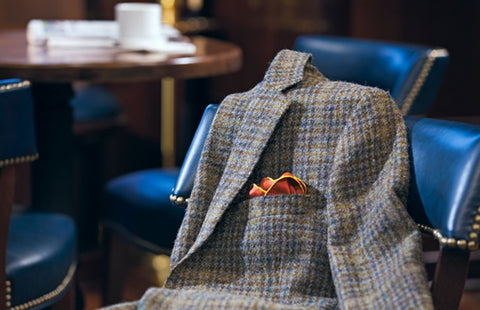
Tweed is the epitome of quintessential British style. Originating in Scotland in the 18th Century, no true gentleman’s wardrobe would be complete without it. Contrary to the mistaken beliefs of the fashion traditionalist, tweed is not only for the colder months. Modern, creative and lightweight takes on tweed featured prominently in the spring/summer 2014 menswear collections, including tweed with a twist, such as vivid blue tweed jackets embellished with gold chains.
As it happens, there is nothing quite as satisfying as slipping a tweed blazer on over a shirt at a garden party which has drifted on into the chilly hours. Bespoke tailoring is the key to getting tweed just right, be it a classic camel herringbone suit for a wedding or a striking, slim-fit, textured blazer to pair with denim. Here are five more things you may not know about tweed.
1) The name ‘tweed’ actually stems from a random mistake.
A cloth merchant in London is said to have misread the word ‘tweel’, which is the Scottish version of twill. The merchant mistook it for the word ‘Tweed’, which is a river in Scotland.
2) The very first Estate Tweed was commissioned by Prince Albert in 1848.
Albert’s Balmoral Tweed is a spotted crimson, white and blue when viewed close-up. From far away it appears grey, to blend with the granite coloured mountains in Aberdeenshire, making it ideal for wearing whilst deer hunting. Soon after, other estate owners followed suit creating their very own Estate Tweeds, to be worn solely by their family and those working on the estate.
3) An amphibian was in fact one of the very first style icons to be seen sporting tweed.
Tweed and celebrity status go hand in hand; Prince Charles and Madonna are two modern day Tweed icons that spring to mind. It was in fact Mr. Toad, from beloved childrens classic Wind in the Willows by Kenneth Grahame, who kicked off the celebrity tweed trend in 1908, with his love of tweed suits and flat caps.
4) There are many variations of Tweed available.
There are thought to be over four thousand unique tweed colour combinations and patterns in common use.
5) Our key supplier of Yorkshire Tweed is Dugdale.
The White Rose Range of Dugdale Caldonaire Yorkshire Tweeds and Twills was launched in 1911 and pays homage to the Rivers Calder, Don and Aire which formed the backbone of Yorkshire’s industries.
